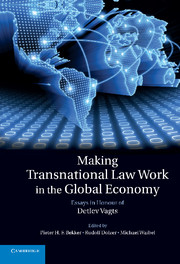Book contents
- Frontmatter
- Contents
- List of contributors
- Foreword: the transnationalism of Detlev Vagts
- List of cases cited
- List of abbreviations and acronyms
- Introduction: a Festschrift to celebrate Detlev Vagts' contributions to transnational law
- 1 Detlev Vagts and the Harvard Law School
- 2 Constructing and developing transnational law: the contribution of Detlev Vagts
- I International law in general
- 3 ‘Hegemonic international law’ in retrospect
- 4 Textual interpretation and (international) law reading: the myth of (in)determinacy and the genealogy of meaning
- 5 The changing role of the State in the globalising world economy
- 6 Sources of human rights obligations binding the UN Security Council
- 7 Is transnational law eclipsing international law?
- 8 Participation in the World Trade Organization and foreign direct investment: national or European Union competences
- 9 From dualism to pluralism: the relationship between international law, European law and domestic law
- 10 Transnational law comprises constitutional, administrative, criminal and quasi-private law
- 11 Founding myths, international law, and voting rights in the District of Columbia
- 12 The tormented relationship between international law and EU law
- 13 International law scholarship in times of dictatorship and democracy: exemplified by the life and work of Wilhelm Wengler
- II Transnational economic law
- III Transnational lawyering and dispute resolution
- Bibliography of Detlev Vagts
- Index
4 - Textual interpretation and (international) law reading: the myth of (in)determinacy and the genealogy of meaning
from I - International law in general
Published online by Cambridge University Press: 17 November 2010
- Frontmatter
- Contents
- List of contributors
- Foreword: the transnationalism of Detlev Vagts
- List of cases cited
- List of abbreviations and acronyms
- Introduction: a Festschrift to celebrate Detlev Vagts' contributions to transnational law
- 1 Detlev Vagts and the Harvard Law School
- 2 Constructing and developing transnational law: the contribution of Detlev Vagts
- I International law in general
- 3 ‘Hegemonic international law’ in retrospect
- 4 Textual interpretation and (international) law reading: the myth of (in)determinacy and the genealogy of meaning
- 5 The changing role of the State in the globalising world economy
- 6 Sources of human rights obligations binding the UN Security Council
- 7 Is transnational law eclipsing international law?
- 8 Participation in the World Trade Organization and foreign direct investment: national or European Union competences
- 9 From dualism to pluralism: the relationship between international law, European law and domestic law
- 10 Transnational law comprises constitutional, administrative, criminal and quasi-private law
- 11 Founding myths, international law, and voting rights in the District of Columbia
- 12 The tormented relationship between international law and EU law
- 13 International law scholarship in times of dictatorship and democracy: exemplified by the life and work of Wilhelm Wengler
- II Transnational economic law
- III Transnational lawyering and dispute resolution
- Bibliography of Detlev Vagts
- Index
Summary
Introduction
Lawyers find certainties very appealing. Perhaps this is the case because they regard the law as stable and predictable. Law's fundamental certainties lie in its rules. The certainties of lawyers are also found there. Rules are called upon to perform the reassuring function of making us believe that what the law-maker considered to be right or wrong is clearly expressed in them. If there is doubt or ambiguity, objective canons of interpretation can readily be used to solve them. The law can thus regain its stabilising function. Reflections about law and its interpretation, which depart from the practitioner's task of saying what the law is, are often looked down upon and strictly relegated to the narrow boundaries of the academic discourse. To be fair, legal philosophers have long engaged in a debate about what interpretation is and how it works, but the discourse within particular legal disciplines is usually confined to the rules and techniques (rules under the guise of technical tools) that lawyers must follow while interpreting legal provisions. Lately, a certain interest has arisen within the community of international lawyers about interpretation, partly due to its potential use for coping with the phenomenon of fragmentation. Interestingly enough, interpretation is regarded as both the problem, given the increasing number of epistemic communities within the discipline, and the solution, for its potential harmonising effect.
- Type
- Chapter
- Information
- Making Transnational Law Work in the Global EconomyEssays in Honour of Detlev Vagts, pp. 34 - 55Publisher: Cambridge University PressPrint publication year: 2010
- 15
- Cited by



